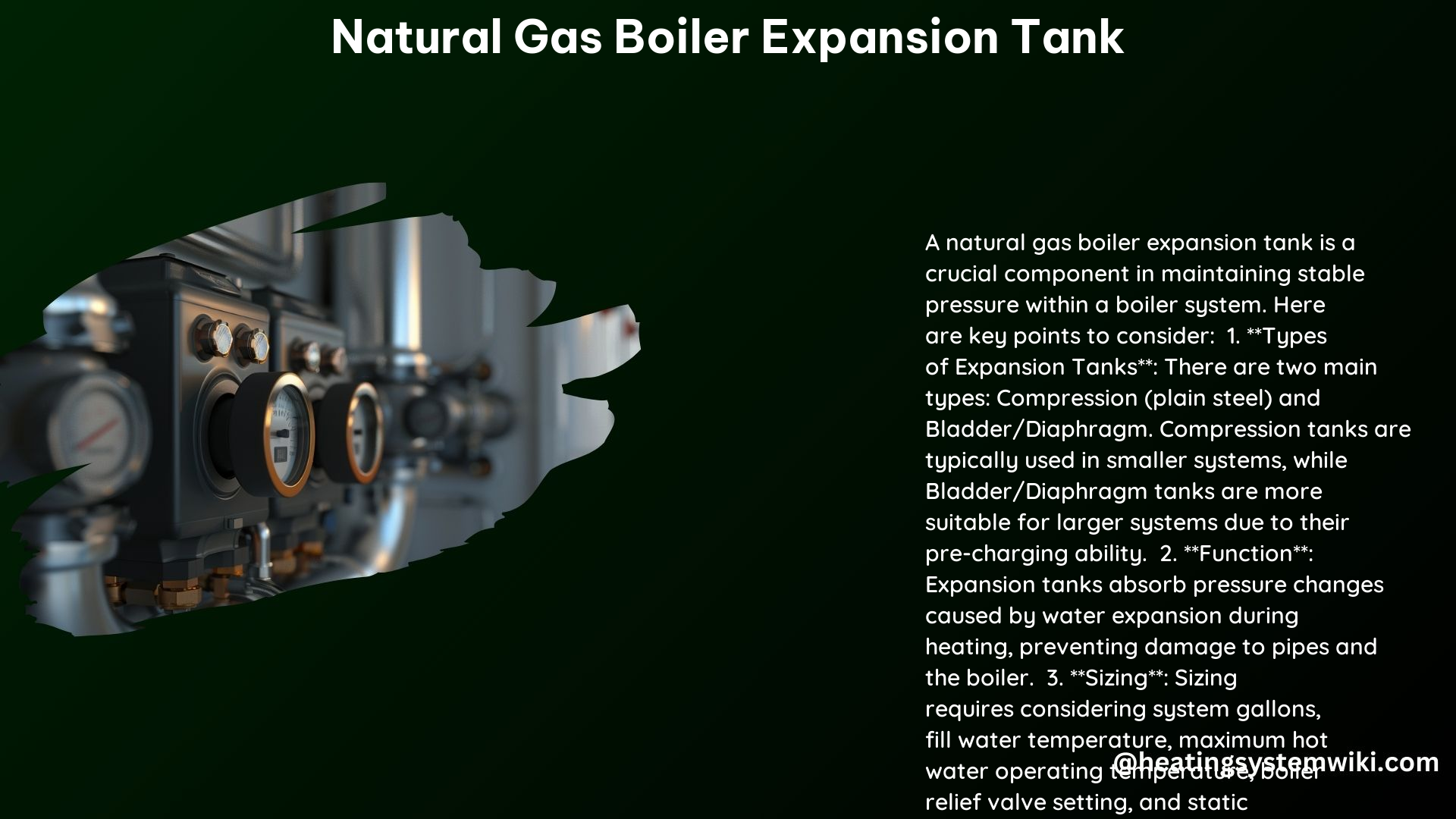A natural gas boiler expansion tank is a crucial component in closed-loop heating systems, responsible for accommodating the thermal expansion of water as it heats up, preventing excessive pressure buildup that could damage the boiler or other system components. This comprehensive guide delves into the purpose, types, sizing, and technical specifications of natural gas boiler expansion tanks, providing a detailed manual for DIY enthusiasts and HVAC professionals.
Purpose of a Natural Gas Boiler Expansion Tank
The primary function of a natural gas boiler expansion tank is to maintain the system’s pressure within a safe range. As water in the heating system heats up, it expands, and the expansion tank allows for this volume increase without causing excessive pressure that could potentially damage the boiler, pipes, or other components. By regulating the pressure, the expansion tank ensures the smooth and efficient operation of the entire heating system.
Types of Expansion Tanks

There are two main types of expansion tanks used in natural gas boiler systems:
- Compression Tanks:
- These tanks are typically mounted horizontally above the boiler and have no internal parts.
- They are often used in smaller systems, such as those found in one- or two-story buildings.
-
Compression tanks rely on the compression of the air inside the tank to accommodate the thermal expansion of the water.
-
Bladder/Diaphragm Tanks:
- These tanks have an internal butyl rubber bladder or diaphragm that separates the system water from the air inside the tank.
- They are pre-charged with compressed air and are often used in taller buildings where space is limited.
- The bladder or diaphragm allows for the expansion of water without directly compressing the air, providing a more efficient and reliable pressure regulation.
Sizing an Expansion Tank
Properly sizing an expansion tank is crucial to ensure the system’s optimal performance and safety. To determine the appropriate size, the following information is required:
- Total System Gallons: The total volume of water in the boiler, piping, and heating coils.
- Fill Water Temperature: The initial temperature of the water in the system, usually around 40-50°F.
- Maximum Hot Water Operating Temperature: The highest temperature the system will reach during operation, typically around 180-200°F.
- Boiler Relief Valve Setting: The pressure at which the boiler’s relief valve opens, usually around 125 PSI.
- Static Pressure: The pressure due to the height of the system, calculated by dividing the total height in feet by 2.31.
Using these parameters, HVAC professionals can calculate the required expansion tank size to accommodate the system’s thermal expansion and maintain the appropriate pressure range.
Can I Use Two Expansion Tanks for a Natural Gas Boiler?
While it is technically possible to use two expansion tanks in a natural gas boiler system, it is not a common practice. In most cases, a single expansion tank is sufficient to handle the thermal expansion of the water and regulate the system’s pressure. However, in larger or more complex systems, the use of two expansion tanks may be necessary to ensure proper pressure regulation and system performance.
Technical Specifications
Natural gas boiler expansion tanks are engineered with the following technical specifications:
Material:
– Expansion tanks are typically made of steel or copper, with durable exteriors to withstand normal wear and tear.
Capacity:
– Expansion tanks come in various sizes, ranging from 2 gallons to 500 gallons or more, depending on the system’s requirements.
– The tank capacity is determined by the total system volume, temperature range, and pressure specifications.
Diaphragm Material:
– The internal bladder or diaphragm of a bladder/diaphragm tank is usually made of butyl rubber, which can be replaced if it ruptures.
Temperature Limits:
– Bladder/diaphragm tanks have a temperature limit of 240°F, while compression tanks can handle higher temperatures up to 250°F.
Pre-Charging:
– Bladder/diaphragm tanks are pre-charged with compressed air to a pressure equal to the highest static water pressure in the system plus 5 PSI.
By understanding the technical specifications and selecting the appropriate expansion tank for your natural gas boiler system, you can ensure optimal performance, safety, and longevity of the heating equipment.
References
- Walmart. (n.d.). Boiler Expansion Tank – Walmart. Retrieved from https://www.walmart.com/c/kp/boiler-expansion-tank
- Rite Boilers. (n.d.). Expansion Tanks – Rite Boilers. Retrieved from https://www.riteboiler.com/auxiliaries/expansion-tanks/
- Heating Help. (2019, September 2). Expansion tank for hot water loop off steam boiler? Retrieved from https://forum.heatinghelp.com/discussion/170988/expansion-tank-for-hot-water-loop-off-steam-boiler
- PexUniverse. (n.d.). Boiler Expansion Tanks by Amtrol & Catefactio – PexUniverse. Retrieved from https://www.pexuniverse.com/heating-expansion-tanks
- F.W. Webb. (n.d.). Expansion Tanks – F.W. Webb. Retrieved from https://www.fwwebb.com/category/heating/expansiontanks-and-accessories/expansion-tanks
